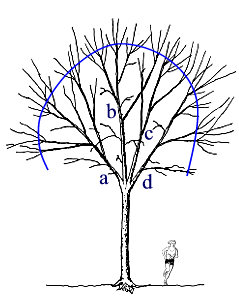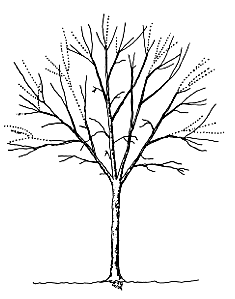Home >
Structural pruning older shade trees
Photos of mature tree pruning.
Before pruning
Problem: This medium-aged tree has four main limbs (a, b, c, d) all originating from one point on the trunk. Each limb appears to be equally dominant. This form is considered weaker than the single-trunk form where one stem dominates and is bigger than all others. Large maturing trees usually perform best and last longest if they grow with one main leader and trunk. This tree was tipped (rounded over) at about the position of the blue line drawn through the canopy causing the proliferation of sprouts at the canopy edge. Tipping and topping also encourage development of weak codominant stems.
|
Remove indicated branches
Solution: Reduce the length of limbs 'a', 'c' and 'd' using reduction cuts and removal cuts. These are the longest branches. After pruning, the tip of limb 'b' should be higher than the tops of all other limbs. This will help limb 'b' become the dominant trunk by 1) slowing growth on limbs 'a' 'c' and 'd' and 2) increasing growth rate on 'b' by providing more sunlight to 'b'. In most cases on large-maturing trees, branches in the lower 15-20 feet of the tree should be kept smaller than half the trunk diameter using this technique. And they should not be allowed to grow up into the tree to become a permanent part of the canopy. Note that no small diameter interior branches were removed. |
After pruning
Solution executed: Small holes were created in the canopy by removing branches from the outer portion of the canopy. These holes will fill with new branches as growth resumes. Trees can receive this light pruning treatment each year to encourage development of good structure. Regular pruning may be required for ten years or more to develop a structure that the tree can sustain. A more aggressive pruning treatment would be to make reduction cuts back to lower lateral branches than indicated above. This would leave larger holes in the canopy but would require less frequent pruning to reach the objective of developing one trunk. |




